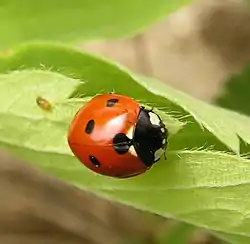天道虫
See also: 天道蟲
Japanese
| Kanji in this term | ||
|---|---|---|
| 天 | 道 | 虫 |
| てん Grade: 1 |
とう Grade: 2 |
むし Grade: 1 |
| kan’on | kun’yomi | |
| Alternative spellings |
|---|
| 天道蟲 (kyūjitai) てんとう虫 瓢虫 紅娘 |

天道虫 (tentō mushi): a ladybug or ladybird.
Etymology
Compound of 天道 (tentō, “celestial path; the sun”) + 虫 (mushi, “bug”).
There are various theories for the derivation. These include:
- So called because the insects fly upward towards the sun.
- So called for their habit of landing on branches and orienting upwards, towards the sky.
Derived species names are generally suffixed with -tentō.
Noun
天道虫 or 天道虫 • (tentō mushi) ←てんたうむし (tentaumusi) or テンタウムシ (tentaumusi)?
- a ladybird (UK), ladybug (US), lady beetle (any beetle of family Coccinellidae)
- Hypernym: 甲虫 (kōchū)
- Synonym of 並瓢虫 (namitentō): an Asian lady beetle, Harmonia axyridis
Usage notes
As with many terms that name organisms, this term is often spelled in katakana, especially in biological contexts (where katakana is customary), as テントウムシ.
Derived terms
Derived terms
- 偽瓢虫 (tentō mushi damashi)
- 赤星瓢虫 (akaboshi tentō, “Chilocorus rubidus”)
- 七星瓢虫 (nanahoshi tentō)
- 並瓢虫 (nami tentō)
- 二十八星瓢虫 (nijūhachihoshi tentō, “Henosepilachna vigintioctopunctata”)
References
- Matsumura, Akira, editor (2006), 大辞林 [Daijirin] (in Japanese), Third edition, Tōkyō: Sanseidō, →ISBN
Further reading
- Etymology at Nihonjiten (in Japanese)
This article is issued from Wiktionary. The text is licensed under Creative Commons - Attribution - Sharealike. Additional terms may apply for the media files.